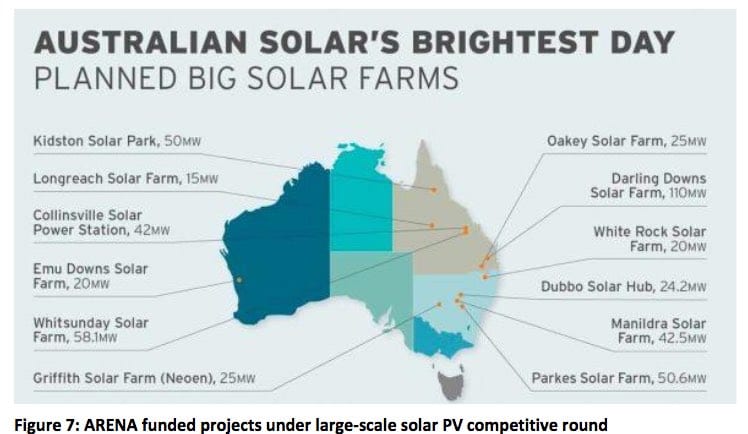Australia is on track to have as much as 12GW of solar PV installed by 2020, boosted by an expected 2.3GW of new utility-scale capacity that is expected to be added over the next three years, off the back of increasing cost competitiveness and government initiatives.
According to the report – the latest annual update from the Australian PV Institute (APVI), produced for the International Energy Agency – solar PV now accounts for 11 per cent of Australia’s national electricity generation capacity and 3.3 per cent of total demand.
But these numbers are set to grow, with the large-scale solar market set to boom, after a year where it played second fiddle to smaller-scale solar, installed on the nation’s homes and businesses in record amounts.
All up in 2016, the Australian market for PV installations fell 16 per cent below the capacity installed in the previous year, to 866MW, owing to the “near-complete absence” of solar farm commissioning for that year, the report says.
The rest of the market, however, grew substantially, taking the nation’s total installed PV capacity to 5.8 GW at the end of 2016, and past the 6GW threshold by Q1 2017.
As noted above, residential rooftop solar installations led the market in 2016, with 123,000 new PV installations taking the total number to more than 1.6 million by the end of 2016 – that’s solar on 20 per cent of the nation’s households.
This trend is expected to continue throughout 2017, particularly in light of the recent near 20 per cent hike in electricity prices across the NEM. It will also be boosted by the continued fall in panel prices, and system prices reaching record lows.
According to the report, average unsupported small-scale solar systems prices were at $1.95/Wp, at the end of 2016, with STCs reducing this to $1.15/Wp.
And the report also points to “surging interest” in grid-connected systems with batteries, with installation volumes numbering around 6750 residential systems in 2016, with a combined total of 42MWh, plus a handful of projects worth a combined 10MWh.
Battery storage uptake by homes has been supported by a number of state government incentives, the report notes, including the City of Adelaide’s 50 per cent rebate on the cost of batteries up to a value of $5000, plus up to a further $5000 for 20 per cent of the price of a PV system.
In the ACT, the government’s Next Generation Storage Program pays a subsidy of $900 per sustained kW of peak output, as part of a rollout of 36MW of distributed storage across 5000 homes and businesses; and the Northern Territory government’s Home Improvement Scheme offers a $2000 subsidy for the installation of rooftop solar and storage systems.
The report also notes “significant growth” in commercial systems in the 30-100kW size range, complemented by a growing volume of industrial rooftop systems in the 101-5000kW range, as you can see in the table below.
But it is the burgeoning large-scale solar sector that looks the most promising, and on this front the report gives a big nod to both ARENA, for its highly successful competitive funding rounds, and to the Clean Energy Finance Corporation, for its continued $250 million Large-Scale Solar financing program.
Figure 8, below, illustrates the CEFC’s funding commitments made to 2017. Figure 7 (above) shows the array of large-scale solar projects funded by ARENA: from 77 expressions of interest, to 22 shortlisted projects, to 12 successful projects, totalling 482MW for $91.7m of ARENA funding.
In economic terms, the report puts the value of Australia’s solar industry at $2.1 billion dollars, and notes that it created a total of 7,210 direct jobs in 2016 alone.
 And it highlights the off-grid market, which it says “continues to be important, particularly in residential applications where PV continues to displace diesel in hybrid power systems.” Off-grid industrial and agricultural applications are also an important market, the report says, including power systems for telecoms, signalling, water pumping and lighting.
And it highlights the off-grid market, which it says “continues to be important, particularly in residential applications where PV continues to displace diesel in hybrid power systems.” Off-grid industrial and agricultural applications are also an important market, the report says, including power systems for telecoms, signalling, water pumping and lighting.
“Significant and growing markets also exist for fuel saving and peak load reduction on diesel grid systems in communities, and tourist locations, with mine sites substantially increasing their adoption of solar,” it says.











